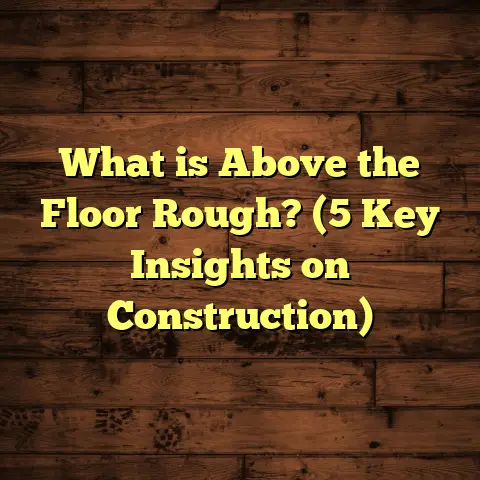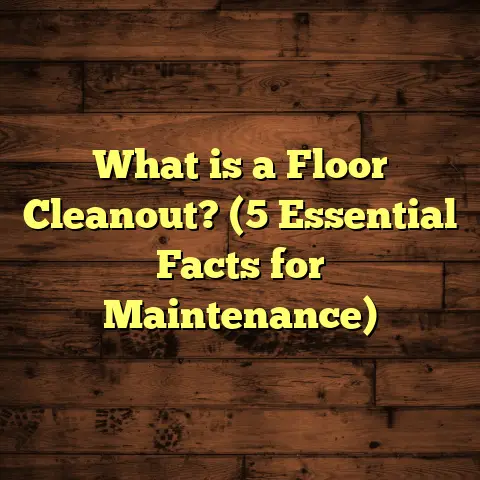What is Slope in Flooring? (5 Key Benefits for Your Space)
Over a hundred years ago, the Romans mastered the art of building aqueducts and roads with just the right amount of slope. They understood that without a slight incline, water would stagnate, causing damage and hazards. This principle of slope has been fundamental ever since, influencing everything from plumbing systems to the floors beneath our feet. Today, as a flooring contractor, I see first-hand how this simple concept can transform a space’s safety, durability, and comfort.
What is Slope in Flooring?
So, what is slope in flooring? At its core, slope refers to the intentional angle or incline built into a floor’s surface. It’s a slight tilt designed to direct water or liquids toward a drainage point or away from entrances and vulnerable areas. The slope is usually expressed as a ratio or percentage—for example, a 1:50 slope means the floor drops 1 unit vertically for every 50 units horizontally.
This might sound technical, but it’s quite straightforward in practice. The goal of adding slope to floors is to make sure water doesn’t pool or sit stagnant. Instead, it flows naturally toward drains or outside areas, protecting your floor from moisture buildup and the problems that come with it.
In my years working on flooring projects, I’ve seen many situations where a lack of proper slope led to costly repairs. Whether it’s water damage under tiles or slippery puddles on patios, the absence of an appropriate slope causes headaches that could have been avoided. I remember one particular bathroom renovation where the floor was perfectly flat when we started. After heavy rains and a faulty shower drain, water pooled on the surface, seeping into grout and damaging tiles. We fixed it by rebuilding the floor with just a 2% slope toward the drain. That small change made all the difference.
How is Slope Measured?
Slope measurement can be a bit confusing if you’re not used to it. It’s typically expressed as a ratio or percentage:
- Ratio: A common way to express slope is as “rise over run.” For example, a slope of 1:50 means the floor rises (or falls) 1 inch vertically for every 50 inches horizontally.
- Percentage: This is just the slope ratio multiplied by 100. A 1:50 slope equals a 2% slope (because 1 ÷ 50 = 0.02, or 2%).
For most interior floors that need drainage (like bathrooms), slopes between 1% and 2% are sufficient. Exterior surfaces like patios or driveways often require slightly steeper slopes—around 2% minimum—to handle larger volumes of rainwater.
The Science Behind Why Floors Need Slope
You might wonder why floors need slope at all. Wouldn’t flat floors be easier to walk on? The truth is, flat floors can trap water. Water left sitting on surfaces creates multiple problems:
- It leads to mold growth beneath flooring materials.
- It weakens adhesives and grout.
- It causes wood to warp and swell.
- It increases slip hazards.
Water doesn’t evaporate efficiently if it pools; instead, it seeps into cracks or joints, accelerating wear and creating health risks.
A slight incline encourages water to flow naturally toward drains or outside areas. It’s similar to how roads are designed to avoid flooding or how gutters channel rainwater off roofs. This principle applies directly to your floors.
Five Key Benefits of Proper Floor Slope
Let me share five benefits I’ve witnessed from installing floors with the right slope—benefits that go beyond just keeping water moving.
1. Improved Water Drainage
The most obvious benefit of floor slope is improved water drainage. When floors are sloped correctly in wet areas like bathrooms, kitchens, or laundry rooms, water flows quickly toward drains instead of pooling.
Consider this: studies show that over 60% of tile failures in bathrooms are linked to poor drainage allowing water to pool beneath tiles. When water pools, it seeps through grout joints and damages adhesives beneath tiles or flooring planks.
A proper slope—usually between 1% and 2%—is enough to direct water effectively without feeling like you’re walking uphill. For example:
- A bathroom floor with a 1/4 inch drop per foot slopes water toward the drain naturally.
- Outdoor patios require at least a 2% slope to handle rain efficiently.
Years ago, I worked on a laundry room where spills and leaks were frequent because the floor was flat. We added a gentle slope toward the floor drain during renovation. Since then, spills flow right into the drain and cleanup became much easier.
2. Enhanced Safety by Reducing Slip Hazards
Floors with standing water are dangerous. Slips and falls cause millions of injuries annually.
The National Safety Council reports that slips and falls account for over one million emergency room visits every year in the US alone. Wet floors increase those risks dramatically.
Having a slight slope ensures water doesn’t stay stagnant on the surface. Instead, it flows off quickly, reducing slip hazards.
In outdoor spaces like patios or ramps, slopes help rainwater drain quickly. This prevents algae buildup that makes surfaces slippery or ice patches in winter.
During one project in a northern state with heavy snowfall, my client was relieved that their sloped patio drained snowmelt quickly. No slippery ice patches formed because water didn’t pool.
3. Longevity of Flooring Materials
Proper drainage helps extend the life of your flooring materials by preventing moisture damage.
Some materials are especially sensitive:
- Hardwood swells, warps, or cups when exposed to moisture.
- Tile grout erodes faster when constantly wet.
- Laminate flooring can swell and delaminate if moisture gets underneath.
When I installed engineered hardwood flooring for a kitchen remodel recently, we designed the subfloor with a slight slope toward the sink drain. Two years later, the client reported no issues with warping or swelling—something uncommon in kitchens without drainage slopes.
4. Easier Maintenance
Floors designed with proper slope make cleaning easier.
Water spills or pet accidents flow naturally toward drains rather than sitting on the surface. This means less scrubbing and wiping to remove puddles.
Mopping becomes more effective because excess water doesn’t accumulate in corners or low spots.
I often recommend sloped floors for mudrooms or pet areas where messes happen frequently. It simplifies cleanup after muddy paw prints or spilled water bowls.
5. Better Indoor Air Quality
This might surprise you: floor slope can affect indoor air quality indirectly by preventing mold growth.
Mold thrives in damp environments—especially under flooring materials where moisture gets trapped.
Mold spores worsen allergies and respiratory problems for occupants.
A study published in a building science journal compared homes with sloped bathroom floors against flat ones. Homes with proper floor slopes reported 30% fewer mold-related complaints due to better drainage and drier environments.
How Much Slope is Right for Different Spaces?
You’re probably wondering what slope you should aim for in different rooms or outdoor areas. Here’s a quick guide based on industry standards and my professional experience:
| Area | Recommended Slope | Notes |
|---|---|---|
| Interior wet areas (bathrooms, showers) | 1% – 2% (1/8” – 1/4” per foot) | Ensures proper drainage without discomfort |
| Exterior patios & decks | Minimum 2% | Handles rainwater and prevents ponding |
| Garage floors | 1% – 3% | Directs vehicle wash water & rain toward drains |
| Balcony decks | 1% – 2% | Avoids standing water & damage |
Too little slope won’t drain properly; too much can feel like walking uphill or cause furniture instability.
I recall one deck installation where I carefully set concrete forms for exactly a 2% slope. Watching rainwater flow off effortlessly convinced my client they made the right call.
Dealing with Different Flooring Types and Slope
Let’s talk about how slope interacts with various flooring materials because each behaves differently under moisture conditions.
Tile Flooring
Tile floors are common in wet areas but sensitive to moisture underneath.
- If tiles are installed on flat floors without slope, water pools beneath due to grout permeability.
- This causes tile loosening or grout erosion.
- Tile installation over properly sloped mortar beds ensures drainage under tiles.
- Waterproof membranes add protection beneath tiles in wet zones.
In one apartment complex project, we replaced flat shower floors with sloped mortar beds plus waterproofing membranes. The difference? Virtually no leaks reported after two years compared to previous complaints.
Hardwood & Engineered Wood
Wood flooring hates moisture exposure:
- Hardwood swells and warps when wet.
- Engineered wood resists moisture better but still needs protection.
- Sloping wood floors slightly in wet zones helps channel spills away quickly.
- Avoid installing wood directly in areas prone to standing water unless sealed properly.
For kitchens or bathrooms with wood floors, I always recommend waterproof mats combined with slight slopes toward drains to protect wood from occasional spills.
Vinyl & Laminate Flooring
Luxury vinyl tiles (LVT) and laminate sometimes tolerate flatter floors but still benefit from slight slopes:
- These materials swell or delaminate if moisture sits underneath.
- Installing them over sloped subfloors improves drainage.
- Vinyl is more water-resistant than laminate but neither should have standing water for long periods.
In laundry rooms where washer leaks occur often, I use vinyl over sloped concrete for better spill management.
Concrete Floors
Concrete slabs can be poured with precise slopes using screed rails or forms during installation:
- Garage floors typically have slopes between 1%-3%.
- Outdoor patios are sloped at least 2%.
- Indoor slab floors under tile in wet areas have slopes around 1%-2%.
Maintaining accurate slopes during concrete pours requires laser levels and skilled labor but pays off in durability.
How I Calculate Slope During Installations
It’s one thing to know what slope you need; it’s another to get it right on site. Over time, I developed a process that ensures accurate slopes:
- Measure existing floor elevations using laser levels.
- Mark required slope gradient on walls or framing.
- Build up subfloor using shims or tapered sleepers if necessary for wood floors.
- For concrete slabs, set screed rails at correct heights before pouring.
- Use laser level tools frequently during installation to check slopes.
- For tile installations, apply sloped mortar beds using screed boards matching desired gradient.
- Double-check final surface with laser levels before finishing work begins.
This process helps me avoid common mistakes like uneven slopes that cause puddling.
Real-Life Case Study: Bathroom Floor Renovation
Let me share one detailed project to illustrate these concepts better.
A homeowner called me frustrated because their bathroom tiles were cracking and lifting just weeks after installation. Upon inspection:
- The subfloor was nearly flat.
- Water pooled near corners after showers.
- Mold odors were present due to trapped moisture under tiles.
We removed all tile and mortar layers and rebuilt the subfloor using a mortar bed sloped at about 2% toward the central drain.
We then applied a waterproof membrane before retiling with porcelain tiles known for durability.
Six months later:
- Tiles stayed firmly attached.
- No visible mold growth.
- Water drained quickly during showers.
- Client reported improved air quality and no odors.
This experience showed me how crucial proper slope really is—not just for aesthetics but for health and longevity too.
Common Mistakes I See Regarding Floor Slope
Even experienced builders sometimes overlook slope during installation, leading to problems I’ve helped clients fix:
- Ignoring slope in wet rooms resulting in pooling water and damaged flooring.
- Excessive slopes making walking uncomfortable or causing furniture instability.
- Uneven slopes creating puddles in low spots instead of draining properly.
- Improper waterproofing combined with poor slope, worsening moisture issues.
- Assuming waterproof flooring means no slope needed, which isn’t true long-term.
If you’re planning any flooring project involving moisture-prone areas, don’t skip thinking about slope!
The Cost Factor: Does Adding Slope Increase Flooring Expenses?
You might ask whether adding proper floor slope makes projects more expensive.
In my experience:
- Adding slope during concrete pours involves careful formwork but doesn’t drastically increase cost.
- For wood subfloors, shimming or tapering joists adds some labor time but minimal material cost.
- Waterproof membranes combined with sloped mortar beds add moderate expense but protect your investment.
- Fixing poor slopes after installation is far more expensive due to demolition and rebuilding costs.
Industry estimates suggest including proper slope upfront adds roughly 5–10% to flooring project budgets but saves thousands in repairs later.
Tools That Help Measure and Implement Floor Slopes
Technology has made installing slope easier and more accurate:
- Laser levels provide precise elevation readings across large surfaces.
- Slope meters measure inclines directly on finished floors.
- Digital inclinometers help set angles during framing or concrete pours.
- FloorTally, an online tool I use regularly, helps calculate costs factoring in slopes and waste percentages—saving time and money during planning.
These tools improve accuracy significantly compared to eyeballing slopes manually as was done decades ago.
How Slope Affects Indoor Design & Aesthetics
You might think adding slope compromises design or comfort—but not necessarily!
Here are some tips I share with clients:
- Keep slopes gentle (around 1%-2%) so they’re barely noticeable underfoot.
- Use flooring materials that look natural on slight inclines (tiles with rectangular shapes hide slopes well).
- Position drains strategically near walls or corners where they’re less visible.
- Combine slopes with subtle transitions like beveled edges for smooth flow between rooms.
Clients often tell me they don’t even notice the floor isn’t perfectly flat but appreciate how dry and safe it feels.
Frequently Asked Questions About Floor Slope
Q: Can you install hardwood flooring on a sloped floor?
A: Yes—especially engineered hardwood which is more stable than solid hardwood. The key is ensuring the slope is gentle enough (around 1%) so planks don’t shift or feel uneven while still allowing drainage if needed.
Q: What happens if there’s no drain? Should floors still have slope?
A: If there’s no drain indoors, slopes still help direct spills away from high-use areas toward exits or less vulnerable zones where mopping is easier.
Q: How do you fix an existing flat floor that needs slope?
A: Options include building up sections with self-leveling compounds shaped into slopes or removing/rebuilding subfloors with tapered sleepers underneath wood flooring for gradual incline creation.
Final Thoughts From My Experience
From countless projects and client stories over the years, I’ve learned that floor slope is one of those small details that pays off big time down the road.
It improves safety by preventing slips; protects your flooring investment by preventing moisture damage; makes cleaning easier; helps maintain healthy indoor environments; and adds longevity to your surfaces—all while being almost invisible if done right.
If you’re thinking about renovating bathrooms, kitchens, patios, garages—or any space exposed to moisture—think about floor slope early on. Talk to your contractor about how they plan to incorporate it properly so you avoid common issues later.
Your floors do more than hold up furniture—they protect your health and safety too. And sometimes all it takes is just a little tilt in the right direction.
If you want specific advice tailored to your home’s layout or planned renovation, feel free to ask! I’m always happy to share insights from my hands-on experience managing hundreds of flooring projects over the years.
Let’s keep your floors dry, safe, and beautiful for years to come!





